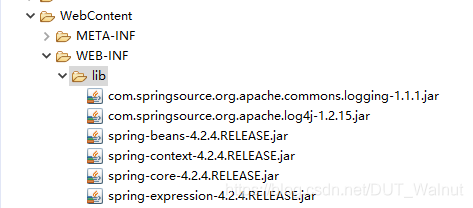spring介绍
什么是spring
Spring 是一个分层的 JavaSE/EEfull-stack(一站式) 轻量级 开源框架。
spring优点
- 方便解耦,简化开发:Spring 就是一个大工厂,可以将所有对象创建和依赖关系维护,交给 Spring 管理
- AOP 编程的支持:Spring 提供面向切面编程,可以方便的实现对程序进行权限拦截、运行监控等功能
- 声明式事务的支持:只需要通过配置就可以完成对事务的管理,而无需手动编程
- 方便程序的测试 Spring 对 Junit4 支持,可以通过注解方便的测试 Spring 程序
- 方便集成各种优秀框架:Spring 不排斥各种优秀的开源框架,其内部提供了对各种优秀框架(如:Struts、Hibernate、 MyBatis、Quartz 等)的直接支持
- 降低 JavaEE API 的使用难度:Spring 对 JavaEE 开发中非常难用的一些 API(JDBC、JavaMail、远程调用等),都提供了封装, 使这些 API 应用难度大大降低
spring搭建
导入jar包

创建一个对象
package bean;
public class User {
private String name;
private Integer age;
public String getName(){
return name;
}
public void setName(String name){
this.name = name;
}
public Integer getAge(){
return age;
}
public void setAge(Integer age){
this.age = age;
}
}
书写配置文件
- 位置任意(建议放在src下
- 配置文件名任意(建议applicationContext.xml

导入约束



注:如果找不到schema的话先试试关掉eclipse试试,然后再不行的话重新导入一次约束试试
书写配置文件
<?xml version="1.0" encoding="UTF-8"?>
<beans xmlns:xsi="http://www.w3.org/2001/XMLSchema-instance" xmlns="http://www.springframework.org/schema/beans" xsi:schemaLocation="http://www.springframework.org/schema/beans
http://www.springframework.org/schema/beans/spring-beans-4.2.xsd">
<!-- 将User对象交给spring容器管理 -->
<bean name="user" class="bean.User"></bean>
</beans>
测试
编写测试类

package test;
import bean.*;
import org.junit.Test;
import org.springframework.context.ApplicationContext;
import org.springframework.context.support.ClassPathXmlApplicationContext;
public class Demo {
@Test
public void fun1(){
//1 创建容器对象
ApplicationContext ac = new ClassPathXmlApplicationContext("applicationContext.xml");
//2 向容器对象“要”user对象
User u = (User) ac.getBean("user");
//打印“user”对象
System.out.println(u);
}
}
测试结果

spring概念
IOC:Inverse of control反转控制
将我们创建对象的方式反转
以前对象的创建是由我们开发人员自己维护,包括依赖关系也是自己注入。
使用了spring之后,对象的创建以及依赖关系可以由spring完成创建以及注入。
DI:Dependence Injection依赖注入
实现IOC思想需要DI做支持。
注入方式
set注入(也用
<!-- 第二种:set 方法的方式 -->
<bean id="user" class="bean.User">
<property name="name" value=" 小王"/>
<property name="age" value="30"/>
</bean>
构造方法注入(推荐
<!-- 第一种:构造方法的方式 -->
<bean id="user" class="bean.User">
<constructor-arg name="name" value=" 小王 "/>
<constructor-arg name="age" value="30"/>
</bean>
字段注入(不推荐
注入类型
值类型注入
<!-- SpEL:Spring Expression Language. 语法:#{ SpEL } -->
<!-- SpEL 的注入的方式 -->
<bean id="user" class="bean.User">
<property name="name" value="#{' 小王'}"/>
<property name="age" value="#{30}"/>
</bean>
<!-- Spring 的复杂类型的注入===================== -->
<bean id="userName" class="bean.User">
<!-- 数组类型的属性 -->
<property name="arrs">
<list>
<value>小王</value>
<value>冠希</value>
<value>天一</value>
</list>
</property>
<!-- 注入 List 集合的数据 -->
<property name="list">
<list>
<value>芙蓉</value>
<value>如花</value>
<value>凤姐</value>
</list>
</property>
<!-- 注入 Map 集合 -->
<property name="map">
<map>
<entry key="aaa" value="111"/>
<entry key="bbb" value="222"/>
<entry key="ccc" value="333"/>
</map>
</property>
<!-- Properties 的注入 -->
<property name="properties">
<props>
<prop key="username">root</prop>
<prop key="password">123</prop>
</props>
</property>
</bean>
引用类型注入
<!-- 注入对象类型的属性 -->
<bean id="person" class="cn.itcast.spring.demo4.Person">
<property name="name" value=" 会希 "/>
<!-- ref 属性:引用另一个 bean 的 id 或 name -->
<property name="car2" ref="car2"/> </bean>
<!--引用了另一个类的属性-->
<bean id="car2" class="cn.itcast.spring.demo4.Car2">
<!-- <property name="name" value="#{'奔驰'}"/> -->
<property name="name" value="#{carInfo.carName}"/>
<property name="price" value="#{carInfo.calculatePrice()}"/>
</bean>
spring中工厂(容器)
BeanFactory(过时) 和 ApplicationContext 的区别:
- BeanFactory :是在 getBean 的时候才会生成类的实例.
- ApplicationContext :在加载 applicationContext.xml(容器启动)时候就会创建.
spring配置详解
bean元素
<beans xmlns:xsi="http://www.w3.org/2001/XMLSchema-instance" xmlns="http://www.springframework.org/schema/beans" xsi:schemaLocation="http://www.springframework.org/schema/beans
http://www.springframework.org/schema/beans/spring-beans-4.2.xsd">
<!-- 将User对象交给spring容器管理 -->
<!-- Bean元素:使用该元素描述需要spring容器管理的对象
name: 给被管理的对象取个名字,获得对象时根据该名称获得对象。可以重复(不推荐),可以使用特殊字符
class属性:被管理对象的完整类名
id属性:与name属性一模一样。名称不可重复,不能使用特殊字符-->
<bean name="user" class="bean.User"></bean>
<!-- 整合 struts1 的时候: <bean name=”/loginAction” -->
</beans>
spring创建元素的方式
空参构造
public class User {
public User(){
System.out.println("User空参构造");
}
}
<beans xmlns:xsi="http://www.w3.org/2001/XMLSchema-instance" xmlns="http://www.springframework.org/schema/beans" xsi:schemaLocation="http://www.springframework.org/schema/beans
http://www.springframework.org/schema/beans/spring-beans-4.2.xsd">
<!-- 创建方式1:空参构造创建 -->
<bean name="user" class="bean.User"></bean>
</beans>
静态工厂方式(了解
create/UserFactory.java
package create;
import bean.User;
public class UserFactory {
public static User createUser(){
System.out.println("静态工厂方式");
return new User();
}
}
Demo.java
@Test
public void fun2(){
//1 创建容器对象
ApplicationContext ac = new ClassPathXmlApplicationContext("create/applicationContext.xml");
//2 向容器对象“要”user对象
User u = (User) ac.getBean("user2");
//打印“user”对象
System.out.println(u);
}
create/applicationContext.xml
<!-- 创建方式2:静态工厂创建
调用UserFactory的createUser方法创建名为user2的对象,放入容器-->
<bean name="user2" class="create.UserFactory" factory-method="createUser"></bean>
实例工厂(了解
create/UserFactory.java
public User createUser2(){
System.out.println("实例工厂方式");
return new User();
}
<!-- 创建方式3:实例工厂方式
调用UserFactory对象的createUser2方法创建名为user3的对象,放入容器-->
<bean name="user3"
factory-bean="userFactory"
factory-method="createUser2"></bean>
<bean name="userFactory"
class="create.UserFactory"></bean>
test/Demo.java
@Test
public void fun3(){
//1 创建容器对象
ApplicationContext ac = new ClassPathXmlApplicationContext("create/applicationContext.xml");
//2 向容器对象“要”user对象
User u = (User) ac.getBean("user3");
//打印“user”对象
System.out.println(u);
}
bean元素进阶
scope属性
| 属性 | 作用范围 |
|---|---|
| singleton(默认值) | 单例对象:被标识为单例的对象在spring中只会存在一个实例 |
| prototype | 多例原型:被标识为单例的对象每次获得时才会创建,每次创建都是新的对象 |
| request | WEB 项目中,Spring 创建一个 Bean 的对象,将对象存入到 request 域中. |
| session | WEB 项目中,Spring 创建一个 Bean 的对象,将对象存入到 session 域中. |
生命周期属性
初始化时的执行方法
通过配置标签上的 init-method作为 Bean 的初始化的时候执行的方法,spring会在对象创建之后立刻调用。
销毁时的执行方法
配置 destroy-method 作为 Bean 的销毁的时候执行的方法。 spring会在关闭销毁所有容器对象之前调用。
spring的分模块配置
在项目主配置文件下导入其他模块配置文件
<beans>
<!-- 导入其他spring配置文件 -->
<import resource="create/applicationContext.xml"/>
</beans>
将spring应用到项目中:管理Service和Dao对象
导包

将Service对象以及Dao对象配置到spring容器
为项目添加applicationContext.xml并书写对象对应的bean
<!-- 配置Dao -->
<bean name="customerDao" class="dao.impl.CustomerDaoImpl"/>
<bean name="linkDao" class="dao.impl.LinkDaoImpl"/>
<bean name="userDao" class="dao.impl.UserDaoImpl"/>
<!-- 配置Service -->
<bean name="customerService" class="service.impl.CustomerServiceImpl">
<property name="cd" ref="customerDao"></property>
</bean>
<bean name="linkService" class="service.impl.LinkServiceImpl">
<property name="cd" ref="customerDao"></property>
<property name="ld" ref="linkDao"></property>
</bean>
<bean name="userService" class="service.impl.UserServiceImpl">
<property name="ud" ref="userDao"></property>
</bean>
在Action中获得Service容器中的对象
在每个action方法中都加入如下代码(错误示范,每次请求都会创建新容器
//1 创建容器对象
ApplicationContext ac = new ClassPathXmlApplicationContext("applicationContext.xml");
//2 获得service对象
CustomerService cs = (CustomerService) ac.getBean("customerService");
在web.xml下新建listener
导入spring-web这个jar包

<!-- 可以让spring容器随项目的启动而创建,随项目的关闭而销毁 -->
<listener>
<listener-class>org.springframework.web.context.ContextLoaderListener</listener-class>
<!-- 可以open type查找对应的类文件,复制完整类名即可 -->
</listener>
<!-- 指定加载spring配置文件的位置,得打开对应的类来寻找配置位置的参数,可以考虑背下来 -->
<context-param>
<param-name>contextConfigLocation</param-name>
<param-value>classpath:applicationContext.xml</param-value>
</context-param>
在java文件某些方法中添加从Application域获得spring容器方法
//1.获得servletContext对象
servletContext sc = ServletActionContext.getServletContext();
//2.从sc中获得ac容器
WebApplicationContext ac = WebApplicationContextUtils.getWebApplicationContext(sc);
//3.从容器中获得CustomerService
CustomerService cs = (CustomerService)ac.getBean("customerService");























 117
117











 被折叠的 条评论
为什么被折叠?
被折叠的 条评论
为什么被折叠?








